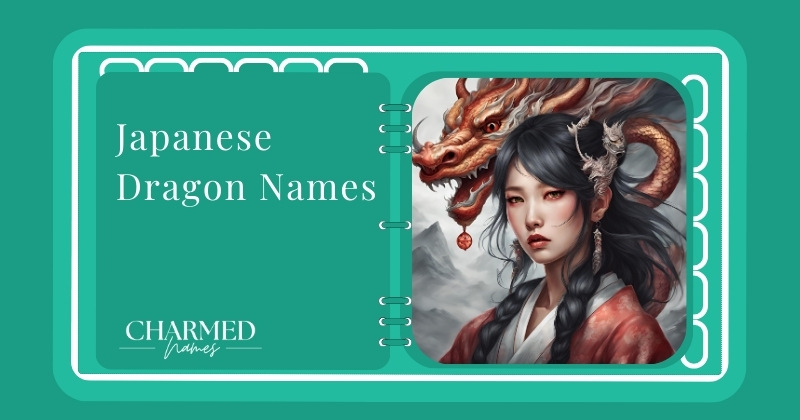670+Top Japanese Dragon Names – Mysterious Legendary
The Japanese fascination with dragons extends far beyond mythical tales, embodying a transformational aspect that resonates with the cycles of life, death, and rebirth.
These magnificent beings shift form, reflecting an eternal evolution and growth that parallels the journey of humanity itself.
The names of these dragons act as a window into a complex, multifaceted world, deeply rooted in mythology and folklore, each name carrying origins and meanings of immense cultural significance.
With traditions that have shaped society for centuries, these names weave a rich tapestry of history, offering a profound understanding of the values that continue to define this extraordinary culture.
Contents
- 1 ||Cultural Names for Japanese Dragon
- 2 ||Legendary Names for Japanese Dragon
- 3 ||Elemental Names for Japanese Dragon
- 4 ||Symbolic Names for Japanese Dragon
- 5 ||Fantasy Names for Japanese Dragon
- 6 ||Contemporary Names for Japanese Dragon
- 7 ||Famous Names for Japanese Dragon
- 8 ||Mythological Names for Japanese Dragon
- 9 Conclusion!!
- 10 FAQ‘s!!
||Cultural Names for Japanese Dragon
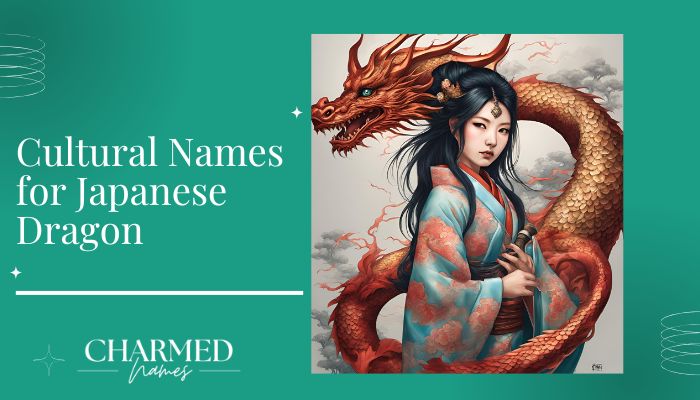
Japanese dragon names embody the essence of mythology, blending cultural significance with the transformational aspects of life, death, and rebirth.
Rooted in folklore, these names reflect the rich tapestry of Japanese traditions, each carrying deep meanings that have shaped society for centuries.
Here are culturally inspired dragon names, each steeped in symbolism and understanding of their origins and evolution.
- Ryūjin – The god of the sea, known for his wisdom and protective nature.
- Fūjinryū – Wind dragon symbolizing freedom and motion.
- Seiryu – Azure dragon, guardian of the East, representing spring.
- Kuzuryū – Nine-headed dragon of Lake Biwa, embodying power and mystique.
- Hakuryū – White dragon, associated with purity and noble spirit.
- Mizuchi – Water serpent, symbolizing rivers and rain.
- Kaida – Little dragon, denoting adaptability and resilience.
- Tatsunoko – Son of the dragon, a metaphor for legacy and honor.
- Ryūga – Dragon fang, representing strength and ferocity.
- Hiryū – Flying dragon, embodying ambition and dreams.
- Kōryū – Shining dragon, symbolizing enlightenment.
- Genbu – Black tortoise dragon, guarding the North with wisdom.
- Ryūkishi – Dragon knight, a symbol of valor.
- Tenryū – Heavenly dragon, representing divinity.
- Goryū – Five-headed dragon, embodying balance and elements.
- Ryūsui – Dragon water, representing flow and adaptability.
- Soraryū – Sky dragon, linked to freedom and vastness.
- Kaenryū – Flame dragon, symbolizing passion and energy.
- Chiryū – Earth dragon, tied to stability and endurance.
- Kazanryū – Volcano dragon, representing destruction and creation
- Inazumaryū – Lightning dragon, embodying speed and power.
- Ryūjinmaru – Dragon circle, a symbol of eternity and unity.
- Aokiryū – Blue-scaled dragon, representing calmness and loyalty.
- Tōkiryū – Winter dragon, tied to stillness and perseverance.
- Kiryū – Noble dragon, embodying dignity and grace.
- Ryūsei – Shooting star dragon, symbolizing fleeting beauty and destiny.
- Shinkiryū – Mirage dragon, representing illusion and mystery.
- Kanryū – Iron dragon, a symbol of strength and resilience.
- Ryūraikō – Dragon thunder, tied to storms and immense energy.
- Nadaryū – Gentle dragon, symbolizing compassion and peace.
- Yamaryū – Mountain dragon, representing protection and fortitude.
- Ryūhō – Dragon phoenix, embodying rebirth and harmony.
- Ryūzetsu – Snow dragon, symbolizing purity and serenity.
- Kairyū – Ocean dragon, tied to vastness and the unknown.
- Ryūmei – Dragon roar, representing might and authority.
- Tatsukage – Shadow dragon, embodying stealth and mystery.
- Sairyū – Western dragon, guardian of the sunset.
- Hoshiryū – Star dragon, symbolizing guidance and hope.
- Ryūzen – Meditation dragon, tied to wisdom and inner peace.
- Fukuryū – Hidden dragon, representing potential and secrecy.
- Kumoryū – Cloud dragon, symbolizing imagination and freedom.
- Enryū – Flame-circle dragon, embodying passion and eternity.
- Ryūkan – Dragon spirit, tied to vitality and the afterlife.
- Seiryūmaru – Circular azure dragon, representing continuity and protection.
- Kyouryū – Strong dragon, a symbol of unmatched power.
- Ryūichi – First-born dragon, denoting leadership and beginnings.
- Shouryū – Soaring dragon, embodying success and ambition.
- Ryūmon – Dragon gate, tied to trials and transformation.
- Hiryūmaru – Flying dragon circle, symbolizing endless pursuit.
- Souryū – Twin dragons, representing unity and balance.
- Shinkiryū – Sacred dragon, tied to divinity and reverence.
- Tenjiryū – Celestial dragon, symbolizing the heavens and cosmic order.
- Ryūin – Dragon shadow, embodying mystery and depth.
- Kazenoryū – Wind dragon, representing movement and adaptability.
- Suiryū – Water dragon, symbolizing life and flow.
- Moryū – Dark dragon, tied to the unknown and enigmatic forces.
- Kinryū – Golden dragon, representing wealth and prosperity.
- Ryūsen – Dragon line, embodying connection and legacy.
- Ryūha – Dragon wave, symbolizing motion and transformation.
- Rokuryū – Six-headed dragon, tied to multifaceted power.
- Tetsuryū – Steel dragon, representing durability and strength.
- Kararyū – Empty dragon, tied to minimalism and wisdom.
- Onryū – Phantom dragon, embodying revenge and unrest.
- Rairyū – Thunder dragon, symbolizing power and fury.
- Kouryū – Yellow dragon, a bringer of wisdom and peace.
- Shiroryū – Silver dragon, representing grace and elegance.
- Ryūkei – Dragon light, tied to inspiration and truth.
- Ryūrin – Dragon scales, a symbol of protection and resilience.
- Jūryū – Beast dragon, embodying primal strength.
- Chōryū – Long dragon, symbolizing endurance and eternity.
- Jinryū – Human dragon, representing the bond between mortals and myth.
- Ryūgaika – Dragon fire petals, tied to beauty and destruction.
- Tokiryū – Time dragon, symbolizing cycles and destiny.
- Kaikiryū – Ocean-cutting dragon, representing exploration and adventure.
- Zenryū – Complete dragon, tied to perfection and fulfillment.
- Jōryū – Castle dragon, embodying fortification and defense.
- Souryuuki – Twin dragon wings, symbolizing flight and freedom.
- Raijiryū – Thunderstorm dragon, tied to chaos and renewal.
- Kairyūmaru – Ocean dragon circle, representing wholeness and flow.
- Kaizenryū – Flame-born dragon, tied to growth and creation.
- Ryūwa – Dragon peace, symbolizing harmony and balance.
- Eiryū – Eternal dragon, tied to timelessness and continuity.
- Ryūhime – Dragon princess, embodying nobility and grace.
- Ryūjinsei – Dragon vitality, symbolizing health and vigor.
- Ryūshō – Rising dragon, tied to ascension and progress.
- Mikazukiryū – Crescent dragon, representing renewal and change.
- Horyū – Phoenix dragon, embodying transformation and rebirth.
- Kōmyōryū – Radiant dragon, tied to enlightenment and clarity.
- Gairyū – Outer dragon, symbolizing the unknown and discovery.
- Ryūmadoka – Dragon circle of tranquility, representing peace and eternity.
- Kyokuryū – Extreme dragon, tied to boundaries and transcendence.
- Kiryūmaru – Noble dragon circle, embodying honor and tradition.
- Fuyuryū – Winter-born dragon, symbolizing endurance and quiet strength.
- Tatsuyume – Dragon dream, tied to vision and ambition.
- Retsuryū – Fiery dragon, symbolizing fierce passion.
- Enjiryū – Garden dragon, representing growth and cultivation.
- Sanyōryū – Three-light dragon, tied to the sun, moon, and stars.
- Jōryūmaru – Tranquil dragon circle, embodying serenity and focus.
- Ryūō – Dragon king, symbolizing ultimate power and authority.
Read also: Funny Names for Santa Claus
||Legendary Names for Japanese Dragon
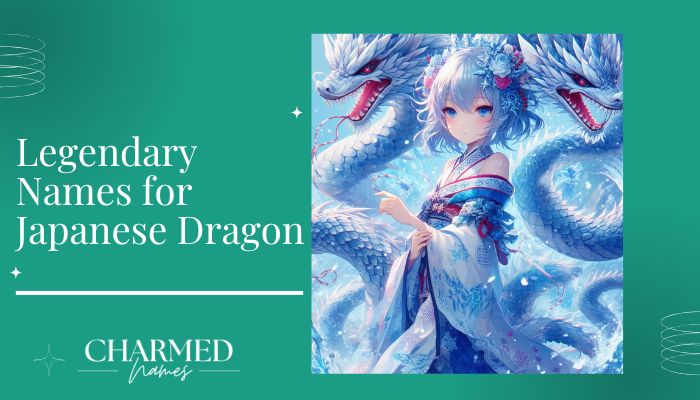
Japanese dragons represent mysticism, growth, and evolution, embodying the cycles of life and rebirth.
These mythical creatures have inspired complex stories in mythology and folklore, with their names revealing cultural significance and rich traditions that have shaped society over centuries.
Below is a list of legendary Japanese dragon names and their unique meanings, reflecting a multifaceted world of ancient wisdom.
- Ryūjin – Sea god and master of tides.
- Fujinryu – Wind dragon, representing storms.
- Kuzuryu – Nine-headed dragon symbolizing power.
- Tatsuo – Dragon man, reflecting strength.
- Seiryu – Azure dragon guarding the East.
- Mizuchi – Water serpent linked to rivers.
- Koryu – Ancient dragon, a symbol of wisdom.
- Hiryu – Flying dragon, bearer of freedom.
- Shenlong – Spirit dragon governing rain.
- Yatagarasu – Three-legged crow-dragon, guiding travelers.
- Hakuryu – White dragon, symbolizing purity.
- Onyxryu – Black dragon, guardian of secrets.
- Shoryu – Rising dragon, a sign of ambition.
- Aokage – Blue shadow dragon, protector of skies.
- Tokoryu – Time dragon, master of destiny.
- Tenguryu – Heavenly dog dragon, keeper of justice.
- Hokoryu – Prideful dragon, emblem of honor.
- Kazeryu – Wind spirit dragon, swift and untamed.
- Tennoryu – Celestial dragon of divine realms.
- Kageryu – Shadow dragon, a bringer of mystery.
- Oryu – Dragon of sound, resonating harmony.
- Byakoryu – White tiger dragon, a guardian spirit.
- Chiryuryu – Earth dragon, symbol of stability.
- Goryu – Five-headed dragon, representing balance.
- Kyouryu – Strong dragon, emblem of resilience.
- Noboryu – Climbing dragon, a mark of ascension.
- Enryu – Flame dragon, bearer of transformation.
- Soryu – Twin dragon, representing duality.
- Doragami – Dragon god, divine protector.
- Kazanryu – Volcano dragon, force of raw power.
- Tenryu – Heavenly dragon, a celestial force.
- Rairyuu – Thunder dragon, master of storms.
- Kinryu – Golden dragon, symbol of prosperity.
- Shinryu – Divine dragon, embodying purity.
- Daikokuryu – Great black dragon, keeper of ancient secrets.
- Tsubasaryu – Winged dragon, free and untethered.
- Tatsuryu – Serpent dragon, sleek and mysterious.
- Araryu – Wild dragon, unbound and fierce.
- Natsuryu – Summer dragon, herald of warmth.
- Yamaryu – Mountain dragon, representing strength.
- Umiryu – Ocean dragon, ruler of the seas.
- Hoshiryu – Star dragon, guiding through darkness.
- Sensoryu – Thousand dragon, reflecting abundance.
- Haruryu – Spring dragon, symbolizing renewal.
- Seiryoryu – Calm dragon, bringer of peace.
- Inariryu – Dragon of harvest, fostering growth.
- Hiryoku – Flying dragon king, ruler of winds.
- Rokuryu – Six-headed dragon, emblem of omnipotence.
- Kazariryuu – Decorative dragon, bearer of artistry.
- Kiryuu – Mist dragon, shrouded in mystery.
- Suiryu – Water dragon, ruler of lakes and rivers.
- Furyu – Flowing dragon, symbolizing fluidity and grace.
- Raijuryu – Lightning dragon, master of electric storms.
- Meiryu – Bright dragon, illuminating wisdom.
- Yokoryu – Horizontal dragon, spreading stability.
- Kokuryu – Black dragon, a guardian of shadows.
- Hokutoryu – Northern dragon, protector of the Pole Star.
- Tengoryu – Celestial guardian dragon, representing divine might.
- Shinryuryu – True dragon, epitome of authenticity.
- Hayaryu – Swift dragon, symbol of agility.
- Yururyu – Gentle dragon, bringing calm and serenity.
- Toraryu – Tiger dragon, merging strength and cunning.
- Choryu – Bird dragon, a sign of transcendence.
- Senshiryu – Thousand-headed dragon, showcasing infinite wisdom.
- Akaryu – Red dragon, associated with passion and power.
- Noryu – Ascending dragon, marking progress and ambition.
- Kaenryu – Blaze dragon, bearer of unrelenting energy.
- Hisuiryu – Jade dragon, a symbol of beauty and wealth.
- Goryukami – Supreme dragon god, protector of realms.
- Unryu – Cloud dragon, veiled in mystique.
- Hozoryu – Treasure dragon, keeper of ancient wealth.
- Kamiryu – Divine thunder dragon, master of storms.
- Tenshiryu – Angelic dragon, a symbol of hope.
- Hyoriryuu – Ice dragon, a harbinger of calmness.
- Fubukiryu – Blizzard dragon, symbolizing relentless force.
- Sanryu – Three dragon spirits, representing unity.
- Sekiryuu – Stone dragon, emblem of endurance.
- Mokuryu – Wooden dragon, signifying growth and roots.
- Kazematsuryu – Wind castle dragon, protector of fortresses.
- Soraryu – Sky dragon, ruler of the heavens.
- Akariryuu – Shining dragon, radiant with glory.
- Kenseiryu – Wise sword dragon, defender of truth.
- Hikaryu – Light dragon, illuminating the path.
- Tairyuu – Peaceful dragon, a bringer of harmony.
- Kaimeryuu – Seashore dragon, a guardian of coastal lands.
- Dairyu – Grand dragon, representing magnificence.
- Kogariryu – Frozen flame dragon, embodying paradoxes.
- Sekiryu – Crimson dragon, representing fiery strength.
- Shiroryu – Silver dragon, symbol of prosperity.
- Hatenryu – Boundary dragon, keeper of thresholds.
- Kuroryu – Dark dragon, veiled in secrecy.
- Tenkariryu – Celestial spark dragon, a sign of inspiration.
- Fukuryu – Hidden dragon, symbolizing patience.
- Raikoryu – Thunder roar dragon, the embodiment of power.
- Chiryokuryu – Earth power dragon, a sign of grounding energy.
- Gekiryuu – Fierce dragon, unleashing strength.
- Shuryu – Protector dragon, defending the weak.
- Retsuryu – Violent dragon, a force of nature.
- Kanryu – Complete dragon, embodying perfection.
Read also: Funny Cowboy Names
||Elemental Names for Japanese Dragon
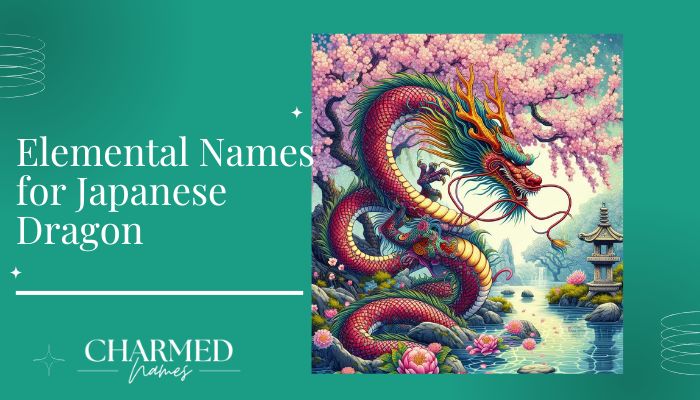
Japanese dragons are often associated with elements like water, fire, and wind, symbolizing power, balance, and nature’s forces.
These mythical creatures have deep ties to the natural world, and their names often reflect their elemental dominance.
Below are names inspired by the elements that you can use for Japanese dragons, each paired with a unique description:
- Tatsuo (龍男) – “Dragon Man” – A name symbolizing strength and power.
- Kaenryu (火炎竜) – “Fire Flame Dragon” – A dragon born from the heart of flames.
- Suijin (水神) – “Water God” – A dragon embodying the essence of water and rivers.
- Fujinryu (風神竜) – “Wind God Dragon” – A dragon tied to the winds and the sky.
- Chikyuryu (地球竜) – “Earth Dragon” – A dragon that represents the power of the earth.
- Reiryoku (霊力) – “Spiritual Power” – A dragon connected to the spiritual realm.
- Raijinryu (雷神竜) – “Thunder God Dragon” – A dragon associated with the force of thunder.
- Seiryu (青龍) – “Azure Dragon” – A guardian dragon of the East, symbolizing balance and calm.
- Karyu (火竜) – “Fire Dragon” – A dragon that breathes fire, representing fierce power.
- Suiryu (水竜) – “Water Dragon” – A dragon that controls the rivers and oceans.
- Kaze (風) – “Wind” – A swift and agile dragon with control over the breeze.
- Tsuchi (土) – “Earth” – A grounded dragon that controls the land and mountains.
- Hoshiryu (星竜) – “Star Dragon” – A celestial dragon that governs the stars and constellations.
- Kurayami (暗闇) – “Darkness” – A dragon of shadow and mystery.
- Hiromu (広武) – “Expanding Fire” – A dragon that expands the power of fire.
- Gokuryu (極竜) – “Ultimate Dragon” – A powerful dragon that represents all elements combined.
- Ryuujin (竜神) – “Dragon King” – A dragon that reigns over all other dragons.
- Sokuryu (速竜) – “Swift Dragon” – A fast-moving dragon that represents speed and agility.
- Meiryoku (明力) – “Bright Power” – A dragon that shines with radiant energy.
- Raitoningu (雷トニング) – “Lightning” – A dragon that controls thunder and lightning.
- Fujin (風神) – “Wind God” – A dragon that commands the winds with mighty force.
- Karyū (火竜) – “Fire Dragon” – A fierce dragon that channels volcanic fire.
- Suishin (水神) – “Water God” – A dragon that controls the oceans and lakes.
- Denryu (電竜) – “Electric Dragon” – A dragon that harnesses the power of electricity.
- Kuroyami (黒闇) – “Black Darkness” – A dragon that dwells in the shadows, cloaked in mystery.
- Yamato (大和) – “Great Harmony” – A dragon symbolizing peace between the elements.
- Shiranui (不知火) – “Unknown Fire” – A dragon associated with supernatural flames.
- Hozu (甫津) – “Elemental Rise” – A dragon representing the rise of natural forces.
- Kyoku (極) – “Extreme” – A dragon whose power reaches the highest extremes.
- Ishin (維新) – “Revolution” – A dragon symbolizing change and transformation in the elements.
- Raikō (雷光) – “Thunder Light” – A dragon with a luminous, thunderous presence.
- Rikuryu (陸竜) – “Land Dragon” – A dragon that reigns over the earth and mountains.
- Seiryu (青竜) – “Blue Dragon” – A wise dragon with control over the oceans and skies.
- Fuyū (風優) – “Gentle Wind” – A dragon that brings calm breezes and gentle gusts.
- Iwao (岩男) – “Rock Man” – A dragon of solid stone, unyielding and steady.
- Genshiryū (原始竜) – “Primitive Dragon” – A dragon that connects with the primordial elements.
- Hōryū (宝竜) – “Treasure Dragon” – A dragon representing rare and powerful treasures.
- Kaminari (雷) – “Thunder” – A dragon of violent storms and explosive energy.
- Mizuumi (湖) – “Lake” – A serene water dragon that controls lakes and small bodies of water.
- Kage (影) – “Shadow” – A dragon that thrives in darkness and mystery.
- Raijin (雷神) – “Thunder God” – A dragon with the power to unleash thunder and storms.
- Tatsu (竜) – “Dragon” – A universal name representing the essence of dragons.
- Yōkai (妖怪) – “Spirit Monster” – A supernatural dragon tied to ghostly forces.
- Ryūgū (竜宮) – “Dragon Palace” – A dragon guarding a hidden, underwater kingdom.
- Kōzō (光蔵) – “Light Vault” – A dragon who brings forth radiant light.
- Tenshiryū (天使竜) – “Angel Dragon” – A dragon of divine light and celestial grace.
- Tōkō (東光) – “Eastern Light” – A dragon that shines with the brilliance of the East.
- Tetsuryu (鉄竜) – “Iron Dragon” – A dragon made of indestructible metal.
- Yamigami (闇神) – “Dark God” – A dragon associated with the dark forces of nature.
- Reiryū (霊竜) – “Spirit Dragon” – A dragon that channels the energies of the spirit world.
- Hinokami (火の神) – “Fire God” – A fire dragon that represents the warmth and fury of flames.
- Gōkū (豪久) – “Mighty Eternity” – A dragon with power that endures for eternity.
- Kinzoku (金属) – “Metal” – A dragon that controls the properties of metal and ore.
- Yōsei (妖精) – “Fairy” – A delicate dragon with ethereal and mystical powers.
- Raikō (雷光) – “Thunder Lightning” – A dragon whose voice is the crack of thunder.
- Asahi (朝日) – “Morning Sun” – A dragon whose breath brings forth the dawn.
- Kōri (氷) – “Ice” – A dragon that controls ice and the cold elements.
- Jōkyū (上級) – “Advanced” – A dragon with supreme mastery over all elements.
- Ryūjin (竜神) – “Dragon God” – A deity-like dragon with dominion over all elemental forces.
- Uroboros (ウロボロス) – “Serpent of Eternity” – A dragon that symbolizes the cycle of life and death.
- Kumo (雲) – “Cloud” – A dragon that floats through the sky, controlling the clouds.
- Arashi (嵐) – “Storm” – A dragon that commands fierce storms and violent weather.
- Hōō (鳳凰) – “Phoenix” – A dragon tied to the immortal fire of rebirth.
- Kōtetsu (鋼鉄) – “Steel” – A dragon made of solid, unbreakable steel.
- Issei (一世) – “One World” – A dragon representing the harmony of all elements in one.
- Chōryū (超竜) – “Super Dragon” – A powerful dragon with abilities beyond the natural world.
- Kageyami (影闇) – “Shadow Darkness” – A dragon whose powers emerge from the dark recesses of the earth.
- Senkyū (千久) – “Eternal Thousand” – A dragon with wisdom and power that spans a thousand years.
- Fūjin (風神) – “Wind God” – A dragon that controls all aspects of the wind.
- Raishin (雷神) – “Thunder God” – A dragon whose voice brings the roar of thunder.
- Kasai (火災) – “Fire Disaster” – A dragon that embodies the uncontrollable nature of fire.
- Aoi (青い) – “Blue” – A serene dragon with the calming influence of the ocean.
- Tenshin (天神) – “Heavenly God” – A dragon with divine powers from the heavens.
- Sōryū (蒼竜) – “Azure Dragon” – A dragon associated with the balance of water and air.
- Kagutsuchi (火の神) – “God of Fire” – A dragon tied to the destructive and creative power of fire.
- Dairyu (大竜) – “Great Dragon” – A mighty and ancient dragon known for its power.
- Shinjū (真珠) – “Pearl” – A dragon that guards precious pearls of wisdom and wealth.
- Kōri (氷) – “Ice” – A dragon with dominion over ice and frost.
- Takamatsu (高松) – “High Pine” – A dragon that represents the eternal strength of nature.
- Mugen (無限) – “Infinite” – A dragon whose power has no limit.
- Yūyami (夕闇) – “Dusk Darkness” – A dragon associated with the night and twilight.
- Yūgen (幽玄) – “Profound Darkness” – A mysterious dragon who dwells in the unseen world.
- Seimei (清明) – “Clear Bright” – A dragon that embodies clarity and pure light.
- Shōrin (小林) – “Small Forest” – A dragon with an affinity for the tranquility of forests.
- Fushimi (伏見) – “Hidden View” – A dragon whose powers lie in the unseen forces of nature.
- Benten (弁天) – “Buddhist Goddess” – A dragon that embodies creativity and inspiration.
- Seikan (清観) – “Pure Vision” – A dragon known for its clarity of sight and perception.
- Yamato (大和) – “Great Harmony” – A dragon that represents peace and unity across the elements.
- Amanogawa (天の川) – “Milky Way” – A dragon tied to the stars and the cosmos.
- Shinsei (神聖) – “Holy” – A dragon with sacred powers, divine and pure.
- Yamatora (山虎) – “Mountain Tiger” – A fierce dragon with the heart of a tiger, protecting the mountains.
- Raizō (雷蔵) – “Thunder Treasure” – A dragon that protects a great treasure of the storm.
- Tatsunami (竜波) – “Dragon Wave” – A dragon that controls the ocean’s waves and tides.
- Fuyutsuki (冬月) – “Winter Moon” – A dragon that thrives in the cold and the calm of winter.
- Suikō (水光) – “Water Light” – A dragon that glows with the light of water’s reflection.
- Hōshin (宝神) – “Treasure God” – A dragon tied to the protection of great treasures.
- Tetsujin (鉄人) – “Iron Man” – A dragon made of unyielding iron.
- Hinose (火の背) – “Fire Back” – A dragon known for its fiery nature and destructive power.
- Hōgen (宝源) – “Treasure Source” – A dragon who guards the source of all riches and knowledge.
Read also: Funny Names for Old Man
||Symbolic Names for Japanese Dragon
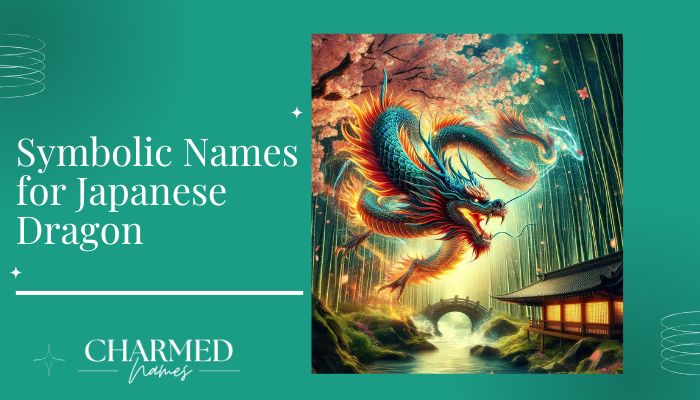
In Japanese mythology, dragons are powerful, spiritual beings, symbolizing wisdom, strength, and good fortune.
Below are symbolic names for Japanese dragons, each with unique meaning and significance in various stories and legends.
- Ryujin – The king of the sea and protector of the oceans.
- Tatsu – A traditional Japanese term for dragon.
- Seiryu – The Azure Dragon, a guardian of the East.
- Fujinryu – The dragon associated with the god of wind.
- Kirinryu – A dragon with characteristics of the mythical unicorn Kirin.
- Koryu – The ancient, wise dragon.
- Yamata-no-Orochi – A fearsome eight-headed dragon from Japanese folklore.
- Hoseiryu – The dragon of the sky, representing celestial power.
- Suijin – Dragon god of water.
- Ryuujin no Kami – Another name for the sea god and dragon, a protector of the seas.
- Shoryu – A dragon symbolizing good fortune and prosperity.
- Doragon-sama – A respectful term for a dragon in Japanese culture.
- Tatsuno-Orochi – A dragon with a noble lineage, often depicted with regal attributes.
- Karyu – The fire dragon, representing passion and intensity.
- Goryu – The five-colored dragon, symbolizing the balance of the elements.
- Buryu – The blue dragon, linked with wisdom and spirituality.
- Orochi no Kage – The shadow of the great serpent-like dragon.
- Wakuryu – A young, vibrant dragon symbolizing renewal.
- Seiryu-Maru – A dragon name meaning a serene and calm presence.
- Akuryu – The red dragon, often associated with strength and vitality.
- Kage-ryu – The dragon of shadows, a mysterious and elusive creature.
- Goryumaru – A traditional dragon name representing the blending of the elements.
- Ryuujin no Tora – A dragon with the soul of a tiger, a symbol of strength.
- Kyoryu – The ancient and mighty dragon of legends.
- Soryu – A dragon representing the sacred and the divine.
- Tatsu-no-Kami – The god of dragons, representing divine authority.
- Hachimanryu – The dragon associated with the god of war and protection.
- Mikuryu – A dragon symbolizing mystery and hidden power.
- Koyryu – The small, yet fierce dragon of the mountains.
- Ryuujin no Hikari – The shining dragon, a symbol of enlightenment.
- Joryu – The gentle, feminine dragon often associated with the moon.
- Raijuryu – The lightning dragon, representing speed and energy.
- Kaminari-sama – The dragon of thunder, often depicted with storms and power.
- Kage-tatsu – The shadow dragon, elusive and swift.
- Tenryu – The celestial dragon, representing heavenly forces.
- Furinkazanryu – A dragon embodying the concept of wind, forest, fire, and mountain.
- Hoshiryu – The star dragon, guiding through the night sky.
- Yukiryuu – The snow dragon, cold and serene.
- Kyuuryu – The mysterious nine-headed dragon of lore.
- Raijinryu – The thunder dragon, associated with fierce storms.
- Shinryu – The divine dragon, symbolizing purity and holiness.
- Inariryu – The fox-dragon, connected with the god of rice and agriculture.
- Kaijuryu – The sea serpent dragon, symbolizing vast, unexplored waters.
- Yamaarashi – A dragon known for its connection to the mountain winds.
- Ibaraki-ryu – A fierce dragon of the forest, often misunderstood.
- Renkiryuu – The dragon of rainbows, symbolizing beauty and harmony.
- Sakuraryu – The cherry blossom dragon, representing the fleeting beauty of life.
- Tatsunagi – The dragon whose presence connects the earth and sky.
- Goryusama – The revered and ancient dragon.
- Narutoryu – The whirlpool dragon, swirling in mysterious patterns.
- Kaminokiri – The godly dragon of mist, elusive and hidden.
- Hiruryu – The blazing dragon, known for its fire and heat.
- Jinryu – A dragon of mercy and compassion.
- Yurei-ryu – The ghostly dragon, a spirit of ancient stories.
- Tetsuryu – The iron dragon, a symbol of unyielding strength.
- Uroboros – The dragon symbolizing eternity, often depicted eating its own tail.
- Tetsuya – The iron-clad dragon of steadfast will.
- Takeminakata – The dragon associated with the god of agriculture and martial arts.
- Baryu – The dragon with control over the winds of the earth.
- Koryumaru – The great serpent-like dragon that guards ancient secrets.
- Sogoro – A dragon that thrives in water and rainstorms.
- Zoryu – The dragon that guards the gates of wisdom.
- Haruryu – The spring dragon, symbolizing renewal and life.
- Fujiryuu – The dragon of the Fuji mountains, sacred and majestic.
- Kirinsama – A dragon with the grace of a Kirin, symbolizing good fortune.
- Izayoi-ryu – The dragon of the fifteenth night, associated with the full moon.
- Raijun – The thunder dragon, always heralding storms.
- Fujiryujin – A dragon connected with the Fuji volcano, power and fury.
- Jigoku-ryu – The hell dragon, often associated with destruction.
- Seiryu-ō – The dragon king, protector of the East.
- Sokuryu – The secretive dragon, wise and ancient.
- Ryu no Kami – The divine and revered dragon of the heavens.
- Kuryu – The dragon of darkness and mystery.
- Tenshiryuu – The celestial dragon, ruling over the heavenly realms.
- Mikokuryu – The dragon of the sacred, often associated with shrines and temples.
- Oni-ryu – The demon dragon, fierce and untamable.
- Ryushin – The dragon heart, symbolizing courage and willpower.
- Yamaga-ryu – A mountain dragon that embodies the majesty of high places.
- Raiuryu – A storm dragon, calling down lightning and thunder.
- Ryuji – The dragon prince, wise beyond years.
- Nokuryu – The guardian dragon of the night.
- Kurozuryu – The black dragon, a symbol of power and authority.
- Arakiryuu – The wild dragon, often shown as unruly and untamed.
- Kyokuryu – A dragon of illusion, capable of deceiving the senses.
- Ichiryuu – The first dragon, a being of origins and creation.
- Yururyu – A dragon of tranquility and peace.
- Tamaryu – The precious dragon, representing wealth and prosperity.
- Yukimura – The snowbound dragon, calm and serene in the winter cold.
- Ryuuno – A dragon of silent wisdom, watching from the shadows.
- Rariryuu – A rare, almost mythical dragon of elegance.
- Sairyu – The dragon of strength, known for its imposing presence.
- Hisui-ryu – The jade dragon, symbolizing beauty and rarity.
- Inuryu – The dog-dragon hybrid, symbolizing loyalty and protection.
- Kazuryu – The dragon of the wind, swift and free.
- Sakuryu – A dragon of spring, bringing new growth and life.
- Kuroinu-ryu – A black dog dragon, fierce and loyal.
- Ryoshu – The noble dragon, representing honor and nobility.
- Onryu – A vengeful dragon, often seeking justice for wrongs.
- Ryuujin-no-Tenshi – The dragon angel, a guardian sent from the heavens
Read also: Funny Names Like Mike Hawk
||Fantasy Names for Japanese Dragon
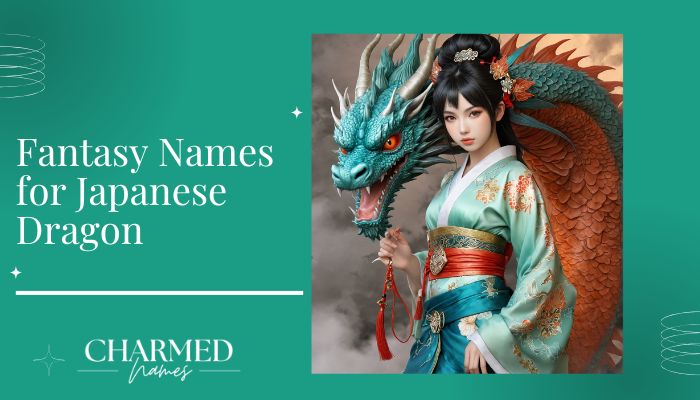
Japanese dragons are mythical creatures deeply embedded in Japan’s folklore, symbolizing power, wisdom, and mystery.
They are often depicted as serpentine beings able to control the elements, particularly water.
Here are unique and fantasy-inspired names for Japanese dragons, each representing different aspects of Japanese culture, history, and nature.
- Ryūjin – The dragon god of the sea, controlling storms and waves.
- Tatsuya – A noble dragon who symbolizes strength and loyalty.
- Karyu – A fire-breathing dragon of the volcanic mountains.
- Seiryu – The Azure Dragon, guardian of the East, associated with healing.
- Kaiju – A massive, ancient creature that stirs fear in all who see it.
- Amateru – Dragon of the sun, bringing warmth and light to the world.
- Fujin – Dragon associated with wind, master of storms.
- Kurohiko – A shadow dragon that lives in the deep forests.
- Nihonryū – A dragon of the Japanese islands, wise and ancient.
- Shoryu – The soaring dragon, embodying freedom and agility.
- Izanami – The dragon linked to the underworld, wise in the ways of life and death.
- Kirinryu – A dragon that embodies the power of the mythical Kirin.
- Raijin – The thunder dragon, feared for its power over lightning.
- Shinjiro – A guardian dragon with an honorable heart.
- Oborogami – A dragon whose body coils around the clouds like mist.
- Hoshiryu – A celestial dragon that guards the stars and planets.
- Suiryu – The water dragon that rules over lakes and rivers.
- Yamato – A dragon named after the ancient Japanese kingdom, wise and noble.
- Onibi – A ghostly fire dragon that haunts the night skies.
- Fujitora – A dragon with the power of both mountain and fire.
- Takeshi – The strong, unyielding dragon of the mountain peaks.
- Kagetora – A dark dragon, shrouded in mystery, feared by many.
- Suijin – A water dragon, often worshipped in ancient rituals.
- Genryū – A dragon that controls the forces of nature.
- Yukiryu – A dragon of the winter, known for its control over ice and snow.
- Hiroryu – A dragon of the sacred temple, guarding ancient knowledge.
- Aokami – A dragon with a fierce, noble heart, often linked with wolves.
- Isami – A dragon representing courage and valor in battle.
- Tsuburaya – A graceful and swift dragon, revered for its agility.
- Kozuka – A dragon that controls the forests, maintaining balance.
- Tetsuryu – A steel dragon, strong and unbreakable.
- Takao – The great dragon of strength, revered by warriors.
- Katsurayama – A dragon who guards the sacred mountains.
- Aomatsu – A dragon tied to the pine trees, ancient and enduring.
- Kuronagi – A dragon who rules over the darkness of the deep ocean.
- Seikyu – The serene dragon of the calm seas.
- Tengiryū – A dragon of the heavens, often linked with birds.
- Takamori – A mighty and proud dragon of the northern lands.
- Sakuraryu – A dragon that symbolizes the beauty of cherry blossoms.
- Soryu – A dragon with unmatched power and wisdom.
- Ibaraki – A dragon that embodies the spirit of the red autumn leaves.
- Kurohiko – A dark dragon of shadows and secrets.
- Yūrei – A ghostly dragon of forgotten realms.
- Raijū – A lightning dragon, known for its speed and strength.
- Hoshimaru – A small, celestial dragon that carries the stars on its back.
- Ryuunosuke – A dragon that guards the wisdom of ancient sages.
- Nagi – A peaceful dragon that resides in serene lakes.
- Satsuki – A spring dragon, symbolizing renewal and rebirth.
- Hajime – A dragon of new beginnings, often associated with dawn.
- Tōryū – A dragon who watches over the sacred paths to enlightenment.
- Saitama – A noble dragon of the plains and grasslands.
- Yamabiko – A mountain dragon that echoes through the valleys.
- Kenshiro – A dragon of the sword, revered for its martial arts.
- Orochi – The eight-headed serpent dragon, feared for its many powers.
- Ibaraki – A fiery dragon, fierce and untamable.
- Sakanoue – A dragon of rivers and streams, flowing gracefully.
- Uroko – A scaled dragon, reflecting the colors of the ocean.
- Seiryū – A celestial dragon that soars above the clouds.
- Hikaru – A dragon of light and purity, often seen in the morning sun.
- Akai – A crimson dragon, associated with fire and strength.
- Raijin – The thunder dragon, master of the storms.
- Tadashi – A dragon of virtue, often associated with honor.
- Jūro – A legendary dragon with the power of the forest.
- Goryu – A guardian dragon that watches over sacred lands.
- Zanryu – A dragon of the storm, controlling both water and wind.
- Fuyuko – A winter dragon, known for its cold and harsh demeanor.
- Azuramaru – A dragon of the sea, praised for its loyalty and beauty.
- Raikou – A dragon that embodies thunder and lightning.
- Shōryū – A dragon who lives in the vast forests, known for its stealth.
- Jinryū – A dragon that represents the flowing rivers of Japan.
- Tsubasa – A dragon of the sky, known for its wings of grace.
- Kenjiro – A dragon warrior, respected in ancient Japanese tales.
- Akiko – A dragon of autumn, signifying change and transformation.
- Kiyomizu – A clear water dragon, serene and wise.
- Kageyama – A dragon of the shadows, associated with secrecy.
- Furimuku – A dragon of the wind, swirling through the trees.
- Shōtoku – A legendary dragon of wisdom and justice.
- Matsumoto – A dragon of the pines, symbolic of strength and endurance.
- Hokuto – A dragon from the north, known for its resilience.
- Kōryū – A royal dragon, revered as a protector.
- Natsu – A summer dragon, symbolizing warmth and vitality.
- Inazuma – A lightning dragon, fast and unpredictable.
- Shinryu – A dragon of divine intervention, known for its guidance.
- Yamabiko – A dragon who echoes the voices of nature.
- Kaito – A dragon of the sky, master of both wind and water.
- Furimaki – A dragon that is known for its mastery over the earth.
- Rokusai – A six-headed dragon, each head representing a different element.
- Shujin – A guardian dragon of temples and sacred grounds.
- Genryū – A dragon associated with the forces of the cosmos.
- Takumi – A dragon skilled in the art of creating masterpieces.
- Hochiryu – A mountain dragon, revered for its wisdom.
- Kanryu – A dragon known for its healing powers.
- Yamato – A fierce dragon, associated with the warrior spirit.
- Ishi – A stone dragon, unmovable and steadfast.
- Hozumi – A river dragon, flowing with wisdom and serenity.
- Kenryu – A dragon of the woods, symbolizing life and death.
- Koguma – A baby bear dragon, gentle yet fierce when threatened.
- Goma – A peaceful dragon that resides in tranquil waters.
- Raiyo – A dragon of thunder, fast and powerful.
Read also: Funny First and Last Names
||Contemporary Names for Japanese Dragon
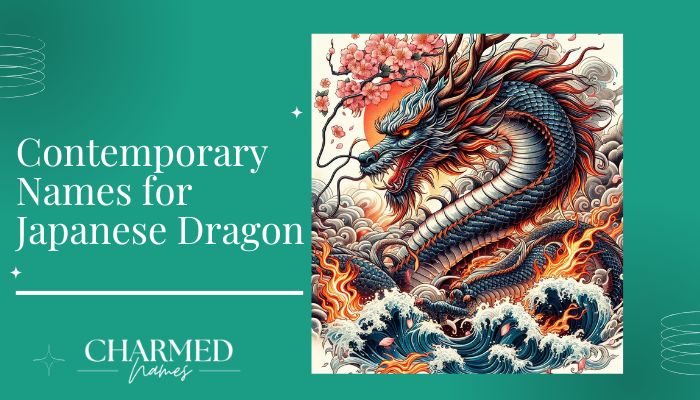
Japanese dragons are powerful and revered creatures in folklore, symbolizing strength, wisdom, and protection.
Here are some modern, unique names inspired by their legendary presence, blending tradition with a contemporary twist:
- Kuroyami – “Black Darkness,” representing the mysterious and shadowy aspect of dragons.
- Tatsuya – Derived from Tatsu, the Japanese word for dragon, symbolizing a powerful and noble figure.
- Ryujin – A fusion of the traditional Ryūjin, the sea god dragon, and modern sensibilities.
- Akiryu – “Bright Dragon,” showcasing the dragon’s radiant energy.
- Kenshin – A name combining strength and conviction, perfect for a dragon with honor.
- Hokuto – Meaning “North Star,” symbolizing a dragon that guides through the unknown.
- Raijin – Named after the thunder god, symbolizing a dragon of immense power.
- Hoshiru – “Star Dragon,” representing a celestial being with immense wisdom.
- Fujin – After the wind god, this dragon would harness the power of the air.
- Yamato – Evoking the historical and mythical past, embodying pride and heritage.
- Noboru – “To Rise,” a dragon that signifies rebirth and transformation.
- Shoryu – “Rising Dragon,” perfect for a dragon destined for greatness.
- Ryoma – Meaning “Dragon Horse,” a unique fusion of strength and grace.
- Seiryu – The “Azure Dragon,” a mythical being connected to the East.
- Isamu – “Brave,” for a courageous dragon who leads with honor.
- Ryuusei – “Falling Star Dragon,” representing rarity and elegance.
- Keiho – Combining Kei (peace) with Ho (law), symbolizing a dragon of justice.
- Shizuku – “Droplet,” representing the delicate power of a dragon that controls water.
- Mizuryu – “Water Dragon,” for a dragon associated with aquatic domains.
- Tatsuo – “Dragon Man,” a powerful fusion of humanity and mythical creature.
- Akihiko – “Bright Prince,” a noble dragon that brings light to darkness.
- Kenshin – “True Heart,” embodying a dragon with pure intentions and wisdom.
- Ryuji – “Dragon Child,” a young but fierce dragon destined for greatness.
- Zenkai – “Complete Victory,” for a dragon who never backs down.
- Katsumi – “Victory and Beauty,” a name befitting a dragon that is both fierce and elegant.
- Sōryū – A traditional but contemporary name meaning “Azure Dragon.”
- Jinryu – “Divine Dragon,” symbolizing a celestial being with untold power.
- Kairo – “Ocean Current,” a dragon of the deep sea with flowing strength.
- Kiyoshi – “Pure,” a dragon that represents spiritual and physical purity.
- Chikyu – “Earth Dragon,” for a grounded and stable force in nature.
- Yamori – “Mountain Dragon,” a powerful creature residing in the high places.
- Sakuraryu – “Cherry Blossom Dragon,” symbolizing fleeting beauty and grace.
- Raikou – “Thunder,” a dragon that controls lightning and storms.
- Keiryu – “Clear Dragon,” a name for a dragon that brings clarity and wisdom.
- Toriniko – “Bird Child,” a dragon with wings that soar like a bird.
- Kasai – “Fire,” symbolizing the dragon’s mastery over flame and destruction.
- Yamatoji – A name that connects the dragon to the great Yamato region.
- Haruo – “Spring Man,” symbolizing renewal and the awakening of life.
- Kenryu – “Sword Dragon,” representing the sharpness of mind and spirit.
- Hiten – “Flying Sky,” symbolizing a dragon that rules the skies.
- Kyūryu – “Nine Dragons,” a mystical name representing unity and strength.
- Sōkai – “Oceanic Sea,” a name for a dragon of great depth and wisdom.
- Ikiru – “To Live,” representing a dragon that breathes life into the world.
- Raiga – “Thunder Fang,” a name for a dragon that strikes with thunderous force.
- Ryuhei – “Dragon Peace,” for a dragon whose power is tempered with peace.
- Kageyama – “Shadow Mountain,” for a dragon that lurks in the unseen.
- Satsuki – “Fifth Month,” symbolizing a dragon that represents growth and renewal.
- Shinryu – “True Dragon,” embodying a dragon that is wise, powerful, and noble.
- Eiko – “Glorious,” a dragon whose beauty and power shine brightly.
- Taiga – “Big River,” symbolizing the strength and might of flowing water.
- Orochi – A mythical name, representing an ancient dragon with a long history.
- Yoroi – “Armor,” symbolizing a dragon that is invincible and unyielding.
- Katsuro – “Victory Son,” representing a dragon that ensures success.
- Seiryu – “Blue Dragon,” one of the Four Guardian Dragons of Japan.
- Toriya – “Bird Dragon,” a dragon that embodies both avian grace and dragon strength.
- Kenichi – “Strong First,” a name for a dragon that leads with power.
- Zokuro – “Dark Dragon,” symbolizing a dragon shrouded in mystery and power.
- Asahi – “Morning Sun,” representing hope and the start of a new day.
- Nagisa – “Seaside,” for a dragon that thrives by the water’s edge.
- Kagari – “Firelight,” symbolizing a dragon whose flame illuminates the world.
- Reiji – “Soul Dragon,” a name for a dragon deeply connected to spiritual realms.
- Kokuryu – “Black Dragon,” symbolizing a fierce and mysterious creature.
- Satoru – “To Understand,” representing a wise and knowledgeable dragon.
- Ishiro – “Stone,” a name for a dragon that embodies endurance and unshakable strength.
- Shuriken – “Thrown Star,” representing precision and deadly accuracy.
- Ryuunosuke – “Dragon Son,” denoting the heir to an ancient dragon lineage.
- Natsuo – “Summer,” a dragon that represents the height of power and passion.
- Fubuki – “Blizzard,” for a dragon associated with ice and cold.
- Gorō – “Fifth Son,” representing the dragon as a family guardian.
- Kiyoku – “Purity,” a name for a dragon that embodies cleanliness and clarity.
- Tenshiko – “Celestial Child,” symbolizing a dragon with divine origins.
- Jūjaku – “Phoenix Dragon,” representing the cycle of life and rebirth.
- Sōjin – “Guardian Spirit,” for a dragon that watches over sacred lands.
- Mikado – “Emperor,” for a dragon that rules the skies with unmatched power.
- Takato – “High Tower,” representing a dragon that stands above all others.
- Haku – “White,” a name for a dragon of purity and goodness.
- Kaen – “Flame,” symbolizing a dragon’s fiery power.
- Goryu – “Five Dragons,” representing multiple forces working in harmony.
- Daiki – “Great Radiance,” symbolizing a dragon’s light in the world.
- Toshirō – “Man of Wisdom,” a name for a dragon of immense intellect.
- Hinata – “Sunny Place,” representing a dragon that brings warmth and light.
- Rairen – “Thunder Lotus,” combining the power of thunder with natural beauty.
- Zankuro – “Enduring Darkness,” symbolizing a dragon that thrives in the shadows.
- Aosai – “Blue Wind,” representing a dragon that controls the wind.
- Yūgi – “Gentle Light,” symbolizing a peaceful and calm dragon.
- Ichirō – “First Son,” representing the strongest of dragons.
- Kōji – “Little Dragon,” a name for a small but fierce dragon.
- Reika – “Spirit Flower,” symbolizing a dragon’s connection to nature.
- Ryuuzaki – “Dragon Cape,” symbolizing protection and power.
- Seika – “Holy Flame,” for a dragon that burns with righteousness.
- Issei – “One True,” symbolizing the ultimate truth.
- Shinra – “Divine Tree,” representing a dragon deeply rooted in the spiritual realm.
- Kaiyō – “Ocean King,” a dragon that rules over vast seas.
- Kiyomi – “Pure Beauty,” for a dragon that combines grace with strength.
- Keiji – “Brave Ruler,” representing a dragon that leads with courage.
- Tensui – “Heavenly Water,” symbolizing purity and peace.
- Tsubaki – “Camellia,” symbolizing a dragon that thrives in all seasons.
- Sōun – “Mountain Cloud,” representing a dragon that hovers between worlds.
- Naruto – “Whirlpool,” a name evoking the power of a dragon that controls water and wind
||Famous Names for Japanese Dragon
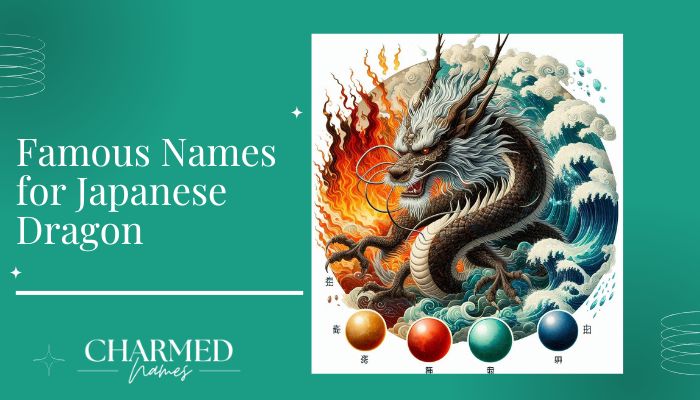
Japanese dragons, known for their rich mythological significance, have inspired countless stories and legends.
These mythical creatures often represent power, wisdom, and protection in Japanese folklore.
Below are famous names of Japanese dragons, each with their unique attributes and meanings:
- Ryujin – The Dragon King of the Sea, symbolizing ocean power and wisdom.
- Orochi – A fearsome eight-headed dragon, often depicted in Japanese mythology as a symbol of evil and chaos.
- Fujin – The God of Wind, sometimes associated with dragon-like features, controlling the winds with his breath.
- Seiryu – One of the Four Heavenly Kings, embodying the East and associated with the color blue.
- Tatsu – A general term for dragon in Japanese, representing strength and spiritual protection.
- Kirin – A mythical creature often mistaken for a dragon, blending aspects of the dragon and unicorn in Japanese culture.
- Kuraokami – A dragon that governs rain and storms, featured in various Japanese legends.
- Wani – A sea monster or dragon, often depicted as a creature of the deep, linked to tales of the ocean.
- Isonade – A terrifying shark-like dragon said to drag ships under the waves.
- Suijin – The water deity, often depicted with dragon-like characteristics, representing the flowing, life-giving force of water.
- Tatsu-no-Orochi – An infamous serpent-dragon from Japanese mythology, known for its immense size and terrifying power.
- Soryu – A dragon that controls storms, frequently depicted in the form of a thunder dragon.
- Ryu-ō – The Dragon King of a vast underwater palace, ruling over aquatic creatures.
- Hakuryu – The White Dragon, considered a symbol of purity and wisdom.
- Jormungandr – While originally from Norse mythology, the Midgard Serpent is sometimes featured in cross-cultural dragon tales that influence Japanese folklore.
- Baku – Often associated with dreams, this creature can also be linked to dragons and is said to devour nightmares.
- Aka-Ryu – The Red Dragon, symbolizing passion and strength.
- Aoi-Ryu – The Blue Dragon, a symbol of serenity and balance.
- Shōryū – A celestial dragon often linked with good fortune and celestial powers.
- Yamata-no-Orochi – Known for its epic defeat by the hero Susanoo, this eight-headed serpent is a classic figure in Japanese legend.
- Tatsuta – A legendary dragon said to inhabit the Tatsuta River, known for its swift movements and watery realm.
- Kitsuneryu – A fox-dragon hybrid, blending fox spirits and dragon attributes in Japanese folklore.
- Kirinriki – A powerful dragon known for its protection and role as a guardian of the earth.
- Mikurya – A dragon that dwells in mountains and is known for guarding sacred sites.
- Uryu – A celestial dragon associated with the stars and the night sky.
- Eirin – A dragon of healing, said to cure ailments through its magical breath.
- Suiryu – A dragon of the water, believed to bring fertility and prosperity to farmlands.
- Ryuujin-no-Mikoto – A title referring to the Dragon God, a revered deity in Japanese mythology.
- Raijin – Often paired with Fujin, Raijin is a god of thunder whose dragon-like form controls the storms.
- Mizuchi – A water dragon associated with rivers and water spirits.
- Kawa-no-Ryu – The River Dragon, a symbol of the life-giving force of water.
- Yamato-no-Orochi – A notorious eight-headed dragon from the tale of the hero Susanoo.
- Kurayami-no-Ryu – A shadow dragon, representing mystery and the unknown.
- Arashi-no-Ryu – A storm dragon, known for causing intense thunderstorms.
- Kage-no-Ryu – The Shadow Dragon, elusive and often seen only in moments of darkness.
- Tatsu-no-Kami – A dragon deity that rules over the natural forces of the earth.
- Kenryu – A warrior dragon, symbolizing strength and bravery in battle.
- Uroko – A scale-dragon, named for the intricate scales that cover its body.
- Hinotsuru – A fire-dragon that can control the flames, often seen as a symbol of destruction and rebirth.
- Suiryuu – A dragon of the sea, often depicted with the power to control the ocean tides.
- Fujinryu – A wind-dragon that can summon gusts and whirlwinds.
- Satoru – A wise dragon, often associated with deep knowledge and intellectual strength.
- Seiryu-no-Mikoto – Another title for the Blue Dragon, ruler of the East, often representing justice.
- Kujaku-Ryu – A peacock dragon, representing elegance and beauty in Japanese lore.
- Yoroi-no-Ryu – A dragon with an armored body, symbolizing resilience and invincibility.
- Ryuujin-no-Kami – A revered water god in dragon form, said to control the tides and the flow of rivers.
- Kuro-Ryu – The Black Dragon, often seen as an ominous and powerful being in folklore.
- Kazenaga – A dragon known for its ability to control the winds and bring balance to nature.
- Wataru – A sea dragon associated with sailing, guiding ships through dangerous waters.
- Koma-Ryu – A dragon that is known for its serpentine shape and swift, unpredictable nature.
- Tsuji-Ryu – A dragon of the crossroads, symbolizing fate and the journey of life.
- Izumo-Ryu – A dragon of the Izumo region, known for its protective nature and association with divine power.
- Mugen-Ryu – The Infinite Dragon, a symbol of eternal life and the endless cycle of nature.
- Chikara-no-Ryu – The Dragon of Power, representing physical strength and might.
- Shinryu – The True Dragon, a being of purity and goodness in Japanese mythology.
- Fushigi-no-Ryu – The Mystery Dragon, known for its secretive nature and elusive presence.
- Ginji-Ryu – A silver dragon, often associated with lunar and celestial elements.
- Daikoku-Ryu – A dragon of abundance, symbolizing prosperity and good fortune.
- Yuki-no-Ryu – The Snow Dragon, linked to the harsh yet beautiful winter landscapes.
- Sora-no-Ryu – The Sky Dragon, an ethereal being that resides in the heavens.
- Tsunami-Ryu – A dragon associated with the mighty and destructive force of tsunamis.
- Kake-Ryu – A dragon who climbs the heavens, symbolizing ambition and strength.
- Kurokawa – The Black River Dragon, connected to the dark, mysterious currents of underground streams.
- Hochi-Ryu – A dragon of joy, often bringing laughter and good cheer.
- Kagekiri – A shadow-slayer dragon, believed to chase away darkness with its light.
- Matsuri-Ryu – A festive dragon, associated with celebrations and festivals in Japanese culture.
- Satsujin-Ryu – The Killing Dragon, a fearsome creature associated with battles and destruction.
- Heiwa-Ryu – The Peace Dragon, symbolizing harmony and balance in the world.
- Onryu – The vengeful dragon, often linked to spirits of the past seeking retribution.
- Seiryu-Tatsu – The Blue Dragon King, known for its regal and authoritative presence.
- Tenkai-Ryu – A dragon of the heavens, known for guiding souls to the afterlife.
- Akai-Ryu – The Red Dragon, embodying passion and fiery energy.
- Kaminari-Ryu – The Thunder Dragon, associated with lightning and the sound of thunder.
- Mizoroku – A dragon of the frozen waters, connected to ice and cold realms.
- Raiju – A dragon-like creature often depicted as an electric beast, associated with lightning.
- Byakko-Ryu – A tiger-dragon hybrid, symbolizing both strength and stealth.
- Nagare-Ryu – The Flowing Dragon, representing change and the flow of time.
- Suisei-Ryu – The Comet Dragon, representing celestial events and cosmic forces.
- Ichiryu – The First Dragon, revered as one of the oldest and most powerful of all dragons.
- Tenshin-Ryu – A heavenly dragon that guards sacred temples and shrines.
- Roku-Ryu – The Six-Dragon, known for its wisdom and mastery of the elements.
- Sekkai-Ryu – A dragon of the realms, connecting all dimensions through its influence.
- Kishin-Ryu – The Demon Dragon, known for its fierce and rebellious nature.
- Rokusen-Ryu – The Dragon of Six Sen, a mystical being tied to the balance of spiritual forces.
- Taizan-Ryu – A dragon of the mountains, known for its connection to the earth and land.
- Aomi-Ryu – A dragon of the ocean depths, symbolizing mystery and unexplored realms.
- Taki-Ryu – A waterfall dragon, representing fluidity and the endless cycle of water.
- Yamato-Ryu – A traditional dragon from the Yamato region, symbolizing heritage and honor.
- Kirin-no-Ryu – A dragon that has the ability to transform into a peacock or unicorn.
- Mizura-Ryu – A swift river dragon, guiding boats safely through fast-moving waters.
- Tenno-Ryu – The Emperor Dragon, often depicted as a ruler of all the dragons.
- Kamigami-no-Ryu – A divine dragon, associated with the gods of Japanese Shinto.
- Amaterasu-Ryu – A dragon linked to the sun goddess, symbolizing light and creation.
- Yomi-Ryu – The Dragon of the Underworld, representing death and the transition to the afterlife.
- Suiyama-Ryu – A mountain dragon, tied to the peaks and the natural landscapes of Japan.
- Shinra-Ryu – The Dragon of Divine Order, often depicted as a protector of sacred rules and rituals.
- Kaijin-Ryu – A sea god dragon, protector of sailors and oceanic realms.
- Ryu-kami – The Dragon Deity, revered for its omnipotent powers over nature and the cosmos.
- Tsubaki-Ryu – A dragon tied to the Camellia flower, symbolizing grace and beauty in Japanese culture.
||Mythological Names for Japanese Dragon
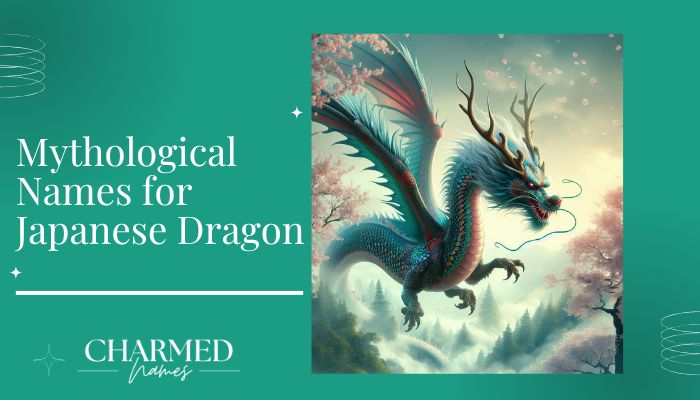
Japanese mythology is filled with powerful and revered creatures, and dragons hold a special place in the culture.
Often symbolic of wisdom, strength, and protection, these dragons are known by unique names that carry deep meanings.
Here’s a list of mythical Japanese dragon names, each with its fascinating history and significance.
- Ryujin – The King of Dragons, ruler of the seas.
- Orochi – An eight-headed dragon, defeated by the hero Susanoo.
- Tatsu – The general term for a dragon in Japanese mythology.
- Seiryu – The Azure Dragon, a guardian of the East.
- Fujinryu – The dragon of wind and storms.
- Kirin – A mythological dragon-like creature, associated with good fortune.
- Aoi-Ryuu – A blue dragon with control over water.
- Mizuchi – A water deity, sometimes depicted as a dragon.
- Ryu-Oh – A powerful dragon king, often associated with the sea.
- Namazu – A dragon associated with earthquakes, believed to cause tremors.
- Yamata-no-Orochi – A fearsome serpent-like dragon from ancient legends.
- Suijin – The god of water, often portrayed with dragon-like features.
- Ryuujin – The dragon god of the sea.
- Tatsuo – A dragon ruler in the mountains.
- Uroko – A dragon with scales resembling those of a serpent.
- Goryu – A storm dragon with immense power over the weather.
- Suiro – A dragon that resides in rivers.
- Shoryu – A dragon representing the majesty of the sky.
- Kuro-Ryu – The black dragon, symbolizing darkness and mystery.
- Byakko – A white tiger-dragon hybrid, a guardian of the West.
- Raijinryu – The dragon that controls thunder.
- Sei-Kai – A sea dragon known for protecting sailors.
- Ryu-Ten – A celestial dragon, guardian of the heavens.
- Tatsu-no-Kami – The god of dragons, a protector of nature.
- Hono-Ryuu – A fire dragon with the power to control flames.
- Isamu – A warrior dragon known for its courage.
- Tatsumaki – The tornado dragon.
- Kamigami – Divine dragons that protect sacred places.
- Takeminakata – A dragon deity associated with agriculture and nature.
- Hiruko – A dragon known to bring about both blessings and misfortune.
- Yoshitsune – A warrior dragon honored in Japanese folklore.
- Ken-Ryuu – A wise dragon that dwells in the mountains.
- Akai-Ryu – A red dragon of destruction.
- Chikyu – A dragon that controls the forces of earth.
- Ryu-Ryu – A double dragon, representing balance.
- Sokuryu – A dragon of travel and exploration.
- Jin-Ryuu – A dragon that embodies intelligence.
- Kozu-Ryu – A small yet powerful dragon.
- Yokai-Ryu – A dragon connected with the supernatural.
- Yukimura – A snow dragon, known for its frosty powers.
- Hoshiyomi – A celestial dragon that watches over the stars.
- Senpuku – A dragon who controls the winds of fate.
- Hakai – A destructive dragon capable of wrecking anything in its path.
- Tategami – A lion-like dragon with a golden mane.
- Kazemaru – A wind dragon with control over gusts.
- Ryujin no Miya – The palace of the dragon god Ryujin.
- Seikenryu – The holy sword dragon.
- Hiryu – The flying dragon, capable of traversing skies and seas.
- Shinjiryu – A dragon that represents faith and spiritual strength.
- Mugen-Ryuu – The limitless dragon.
- Seishinryu – A dragon spirit that symbolizes inner peace.
- Furorii – A dragon of fury, known for its wrath.
- Kasai-Ryu – A fire-breathing dragon of great power.
- Inazuma – A lightning dragon, known for speed.
- Kitsune-Ryuu – A fox-dragon hybrid.
- Zanryu – A violent dragon from the depths of the ocean.
- Kuroi-Ryuu – A dark dragon with a hidden agenda.
- Kakehashi – A dragon that bridges the gap between heaven and earth.
- Suishou-Ryu – The dragon that controls the flow of rivers.
- Katori-Ryu – A dragon named after an ancient shrine.
- Ryu-Kage – The shadow dragon, embodying the mysteries of the dark.
- Sekkai-Ryu – The dragon of the five elements.
- Miyako-Ryu – The dragon of the capital city.
- Chiryu – A dragon that connects the land and the sea.
- Kageyama – A mountain dragon with control over darkness.
- Sapporo – A snow-covered dragon that brings winter storms.
- Kasuga – A dragon that watches over the plains.
- Oda-Ryu – A dragon that symbolizes history and war.
- Kuro-Ryuu – A black dragon of mystery and darkness.
- Koten – A wise dragon known for its sagacity.
- Tajima-Ryu – A regional dragon revered for its protection.
- Chikara-Ryuu – The dragon of strength and perseverance.
- Zuiyo – A dragon revered for its divine purpose.
- Taka-Ryu – The high-flying dragon.
- Shiro-Ryu – A dragon symbolizing purity and good fortune.
- Tachikawa – A dragon known for its speed and agility.
- Ryugetsu – A moon dragon associated with lunar power.
- Suikyou-Ryu – A water dragon from deep in the ocean.
- Taizan-Ryuu – The dragon of Mount Taizan.
- Gensou – A dragon of illusion and dreams.
- Ryu-Ga – A dragon that brings forth harmony.
- Aokami – A wolf-dragon hybrid with immense power.
- Rei-Ryu – A dragon that embodies nobility and grace.
- Kujaku-Ryu – A peacock-dragon, known for its colorful scales.
- Kohen-Ryu – A dragon revered in ancient rituals.
- Yama-Ryu – A dragon of the mountains, embodying endurance.
- Fugen – A peaceful dragon that promotes calm and serenity.
- Shosai-Ryuu – The dragon that brings prosperity.
- Asahi-Ryu – A dragon of the rising sun.
- Ryojin – A dragon god worshipped for protection.
- Betsu-Ryu – A dragon that represents individuality.
- Sanpaku-Ryu – A dragon that can see beyond the physical realm.
- Mizu-Ryu – A water dragon that blesses the land.
- Tetsu-Ryu – A metal dragon with formidable strength.
- Shinku-Ryu – A dragon with the power to control deep red energy.
- Kan-Ryu – A calm and peaceful dragon.
- Kaga-Ryu – A dragon connected to the Kaga region.
- Hakuryu – A white dragon that embodies peace and tranquility.
- Gyorin-Ryu – A dragon symbolizing enlightenment and wisdom
Conclusion!!
In conclusion, Japanese dragon names carry deep cultural significance, blending mystery, power, and wisdom in each one.
These legendary creatures have been a symbol of strength, protection, and transformation throughout Japanese history, with names that reflect their awe-inspiring nature.
Whether rooted in mythology, folklore, or modern adaptations, these names continue to captivate imaginations worldwide.
By exploring these dragon names, we not only dive into the rich tapestry of Japanese tradition but also honor the mythical beings that have shaped storytelling for centuries.
Whether you’re a fan of mythology or simply intrigued by the majestic presence of dragons, these names offer a glimpse into an enchanting world of ancient power and mysticism.
FAQ‘s!!
What are some of the most famous Japanese dragon names?
- Ryujin: The most well-known Japanese dragon, often portrayed as a sea god.
- Orochi: An eight-headed serpent dragon from Japanese mythology, symbolizing chaos and destruction.
- Suijin: The dragon god of water, associated with the power of rivers and lakes.
- Tatsu: A general term for dragons in Japanese culture.
What is the significance of dragons in Japanese mythology?
In Japanese mythology, dragons are considered powerful and sacred creatures. They are usually associated with water, particularly rivers, seas, and storms. They are also seen as guardians and bringers of good fortune, prosperity, and strength. Dragons often have connections to both the natural and spiritual worlds.
What does Ryujin symbolize in Japanese culture?
Ryujin is the god of the sea and the ruler of dragons in Japanese mythology. His name is derived from “ryu” (dragon) and “jin” (god). He controls the tides and the waters, and in many legends, he plays a role in both aiding and challenging heroes. Ryujin is often depicted with a palace beneath the sea and is revered for his immense power over nature.
Why are Japanese dragons considered guardians?
Japanese dragons are often seen as protectors of water, guarding rivers, seas, and lakes from harm. In some stories, they are also guardians of sacred places or spiritual entities, protecting both the natural and supernatural worlds. Their water connection gives them the power to provide both life and destruction, reinforcing their role as caretakers of balance.
These questions and answers offer insights into the mysterious and legendary world of Japanese dragons, highlighting their significance in mythology and culture.

